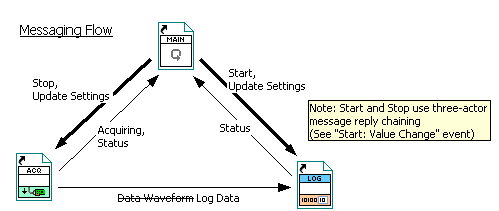Search the Community
Showing results for tags 'actor model'.
-
Version 2.1.7
2,249 downloads
Advanced messaging made simple! Messenger Library is a library for message passing using a variety of powerful Messaging Patterns, and a set of Templates for easily creating parallel modules to interact with those Patterns. Together, these comprise a powerful and deep framework for rapid application development. Communication patterns supported and other features include: -- Request-and-wait-for-Reply -- Asynchronous Request-Reply, where the reply is sent to a "reply address" attached to the request -- Scatter-Gather: Requests sent to multiple addresses, with all Replies gathered together in order -- Register-Notify, where one process sends a registration message to another in order to subscribe to published messages. -- Future Token, a reference to a future Reply not yet made -- Asynchronous Dialog: query the User without blocking (User's response sent as a message) -- Delayed Request: message sent with a set asynchronous delay -- Metronome, a source of precisely-timed periodic messages -- Timeout Watchdog: trigger an action if something expected doesn't happen Freely intermix communication by Queues, User Events or Notifiers. First-class support for TCP communication, allowing easy interaction of multiple executables using any of the Messaging Patterns. Also supports UDP, including multicast. Module Templates are simple, consisting of a single VI and a single loop, and are robust against race conditions (unlike the more complex "Producer Consumer" NI templates) Includes two utilities under the menu "Tools>>Messenger Library": -- a utility to create a new parallel modules from a set of well-tested templates -- a Manager utility to see all running Modules Multiple Examples are included. Of particular interest are: -- An example developed over a series of YouTube videos (linked below) -- A redo of the standard "Continuous Measurement and Logging" Example using Messenger Library -- TCP Reconnecting Example, showing easy network communication with handling of temporary disconnects Note: Messenger Library is intended to promote actor-oriented design, but is not related to the Actor Framework. ***Introductory Videos are on a YouTube channel.*** ***A great summary of many Messenger Library sources, provided by Bob W Edwards*** JDP Science Tools group on NI.com. Original conversation on this work is here. Now hosted on the LabVIEW Tools Network (but note that the latest version will often be on LAVA) -
View File Messenger Library An extensive library for passing messages between parallel processes. Generalizes the communication method, allowing the message sender to use the method provided by the receiver. Supported communication methods include wrappings of simple queues, user events, and notifiers, as well a more complex channels such as a TCP server and client. In addition, one can configure simple forwarding addresses (“Observers"), which can send messages to multiple destinations, optionally with modifications such as adding a prefix to the message label, relabelling, or substituting a different message. Communication patterns supported include request-reply (asynchronous or synchronous), where the reply is sent to a "reply address" attached to the request, and register-notify, where one process sends a registration message to another in order to subscribe to a series of updates. Also supports scatter-gather, the gathering of replies from multiple senders into an array of messages. An option framework for dynamically-launched VI "actors" is also provided, including example templates, which can be accessed via the Tools menu (from an open Project, select Tools>>Messenger Library>>Create Actor from Template..). An "Actor Manager" debug tool is also installed under the Tools menu. Please note that this package has nothing directly to do with the NI Actor Framework (other than both packages are influenced by the Actor Model). ***Introductory Videos are on a YouTube channel.*** ***A great summary of many Messenger Library sources, provided by Bob W Edwards*** JDP Science Tools group on NI.com. Original conversation on this work is here. Now hosted on the LabVIEW Tools Network (but note that the latest version will often be on LAVA) ***NOTE: latest versions require VIPM 2017 or later to install.*** Submitter drjdpowell Submitted 11/27/2012 Category LabVIEW Tools Network Certified License Type BSD (Most common)
-
I’m hoping to add some sample projects to my “Messenging” package, and I thought it would be easy and instructive to rework one of NI’s templates, “Continuous Measurement and Logging”, as it is already somewhat actor-like with three communicating modules. Attached is a (back-saved for 2011) copy of the NI project, with my version included (run “Main.vi” for the original, “Main.lvclass:Actor.vi” for my version). I kept the basic functionality the same, but couldn’t resist changing some of the UI (in the old code, “Main” controls the UI; in the new code, published state messages from the Acquisition and Logging Actors set the UI). Continuous Measurment and Logging with Messenging.zip Any comments appreciated. Is this example less clear than the NI original? Why? How could I improve it? In particular, is code like this (the most complicated interaction, I think) understandable without heavy documentation? It’s a “Start Logger, then Start Acquisition, then Unset the Busy Cursor” three-actor chain message: I’m thinking of making a “Send Chain Message” subVI (that accepts arrays of addresses and message labels) to replace the above code. — James





